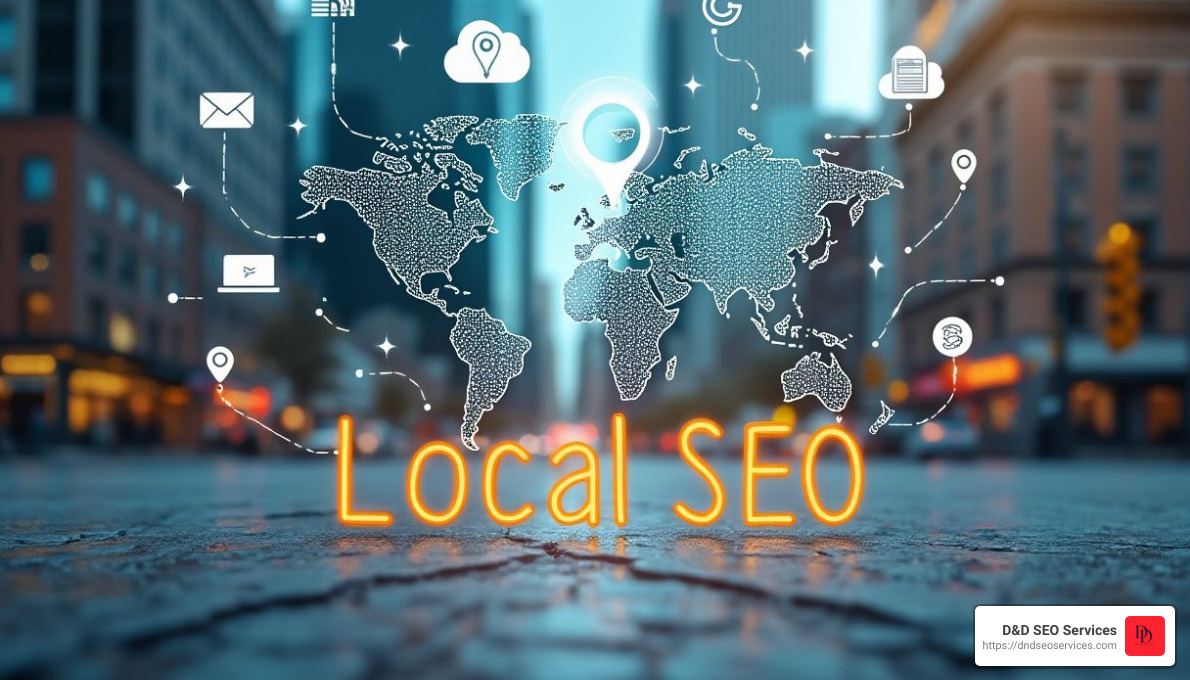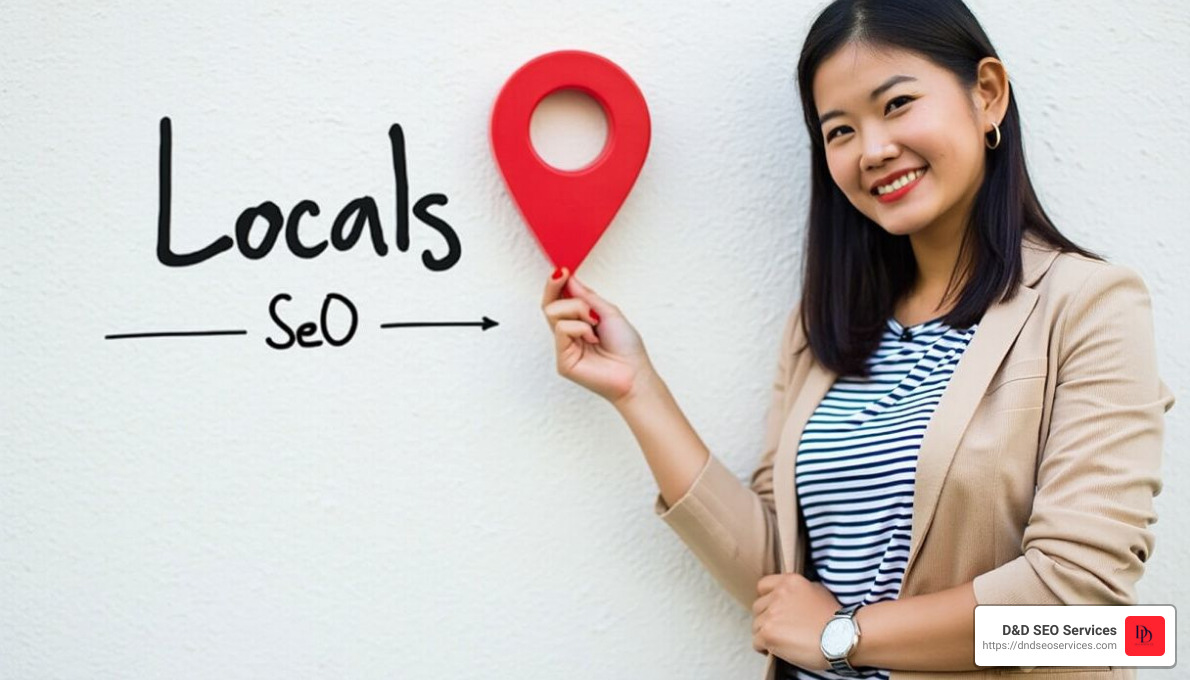The Importance of On the Map SEO
On the Map SEO is essential for local businesses looking to improve visibility and attract more customers. Here’s a quick overview:
- Importance of SEO: Improves your company’s online presence.
- Local SEO: Boosts visibility in local searches.
- Digital Marketing: Integrates with other digital strategies for maximum growth.
Mastering On the Map SEO can put your business on the radar of potential customers who are searching for the services you offer. Local SEO is crucial not only for traditional storefronts but also for any business serving a specific geographic area.
I’m Danielle Birriel, founder of D&D SEO Services. With over a decade of experience, I’ve helped numerous businesses climb the search rankings through effective On the Map SEO strategies.
Ready to dive deeper into how you can achieve this? Let’s get started!
Understanding “On the Map SEO”
On the Map SEO is all about making your business visible on Google Maps and other local search platforms. When people look for services or products in their area, you want your business to appear front and center. This strategy is crucial for attracting local customers and boosting your online presence.
Google Maps: Your Digital Storefront
Google Maps is not just for finding directions; it’s a powerful tool for local businesses. When someone searches for “coffee shops near me” or “best Italian restaurants in [city],” Google Maps displays a list of relevant businesses. Being listed here means more visibility and more foot traffic.
Local Search: The Key to Being Found
Local search refers to the process of optimizing your online presence to attract more business from relevant local searches. According to D&D SEO Services, 97% of search engine users search online to find a local business. This means that if your business isn’t optimized for local search, you’re missing out on a huge chunk of potential customers.
Enhancing Business Visibility
To improve your business visibility, you need to focus on several key areas:
- Claim and Verify Your Google Business Profile: Make sure your business is listed on Google Maps. If it already is, claim it and verify your ownership. This is the first step to getting noticed.
- Complete Your Profile: Fill out all the details accurately, including your NAP (Name, Address, Phone Number), hours, website, and category. Add high-quality photos to showcase your business and products/services.
- Gather Reviews: Encourage satisfied customers to leave reviews. Positive reviews boost your credibility and improve your ranking on Google Maps. Actively respond to reviews to show engagement.
- Local Citations: Ensure your business is listed on various local directories with consistent NAP information. This helps search engines verify your business’s legitimacy and improves your local search ranking.
- Use Relevant Categories: Choose the most relevant categories for your business. This helps Google understand what your business is about and match it with relevant searches.
- Add Photos: High-quality images make your listing more attractive and engaging. Update them regularly to keep your profile fresh.
- Regular Updates: Keep your business information up to date, especially during holidays or special events. This ensures that potential customers have the most accurate information.
- Engage with Customers: Use Google Posts to share updates, events, promotions, and limited-time offers. This keeps your listing active and informs potential customers about what’s new.
By following these steps, you can significantly improve your business’s visibility on Google Maps and local search results. This is the essence of On the Map SEO: making sure your business is easily found by those who need your services the most.
Ready to dive deeper into how you can achieve this? Let’s get started!
10 Key Steps to Rank Higher in Google Maps
To get your business on the map and rank higher in Google Maps, follow these 10 key steps:
1. Claim Your Google Business Profile
First, you need to claim and verify your Google Business Profile (GMB). This ensures your business appears in local search results and Google Maps. It’s like planting your business flag on the digital map. Follow Google’s verification process carefully to avoid any inaccuracies that could mislead customers.
2. Post Linked Content
Regularly update your GMB with linked content. This can be updates, events, promotions, and limited-time offers. Google Posts are mini-blogs that appear directly in your GMB listing. They allow you to share updates, offers, and events. Each post can be up to 300 words and include a photo, date range, and a clickable call to action. Regular updates show Google that your business is active, which can improve your rankings.
3. Optimize Business Information
Fill out every section of your GMB profile. This includes your business name, address, phone number, hours, website, and a brief description. The more complete your profile, the more trustworthy you appear to both Google and potential customers. Businesses with complete profiles are 50% more likely to convert leads into customers.
4. Gather Reviews
Encourage your customers to leave reviews on your GMB profile. Reviews are a powerful signal of trust and activity. Consistent, positive reviews can significantly boost your visibility. According to research, businesses start seeing more noticeable, organic leads once they accumulate around 100 relevant reviews.
5. Build Local Citations
Ensure your business is listed in local directories like Yelp, Yellow Pages, and the Better Business Bureau. Local citations help search engines verify your business’s legitimacy. Use tools like Whitespark or BrightLocal to find relevant citation sources.
6. Maintain NAP Consistency
NAP stands for Name, Address, and Phone number. Keeping this information consistent across all platforms is vital. Even small discrepancies can confuse search engines and lower your rankings. Consistent NAP information can improve your website’s performance by up to 16%.
7. Use Relevant Categories
Choose the most specific primary category that fits your business. You can add additional categories, but make sure they are relevant. For example, if you’re a general contractor, your primary category might be “General Contractor,” and additional categories could include “Home Builder” and “Remodeler.”
8. Add Photos
Adding photos to your GMB profile can make your listing more attractive and engaging. Photos of your business, products, or services can help potential customers get a better sense of what you offer. Listings with photos receive 42% more requests for directions and 35% more click-throughs to websites.
9. Regular Updates
Keep your GMB profile updated with the latest information about your business. This includes changes in hours, new services, or special offers. Regular updates signal to Google that your business is active and reliable.
10. Engage with Customers
Respond to reviews and answer questions on your GMB profile. Engaging with customers shows that you value their feedback and are committed to providing excellent service. This can improve your business’s reputation and encourage more customers to choose your services.
By following these steps, you can significantly improve your business’s visibility on Google Maps and local search results. This is the essence of On the Map SEO: making sure your business is easily found by those who need your services the most.
Ready to dive deeper into how you can achieve this? Let’s get started!
Local SEO Best Practices for 2024
Google Local Map Pack
The Google Local Map Pack is a powerful tool for local businesses. It displays the top three local business listings relevant to a user’s search. Being featured in this pack can significantly boost your visibility. To get there, make sure your Google Business Profile is complete and updated regularly. Include accurate business information, such as your address, phone number, and hours of operation. Also, gather and respond to customer reviews, as they play a crucial role in your ranking.
Mobile Optimization
When most searches happen on mobile devices, mobile optimization is no longer optional—it’s essential. Ensure your website is mobile-friendly by using responsive web design. This means your site should look and function well on all devices, from smartphones to tablets. A mobile-optimized site improves user experience and helps you rank higher in mobile search results.
Voice Search
Voice search is becoming increasingly popular with the rise of smart speakers and virtual assistants like Siri and Alexa. To optimize for voice search, focus on natural language and long-tail keywords. People use more conversational phrases when using voice search, so your content should reflect this. For example, instead of “best pizza NYC,” consider “where can I find the best pizza in New York City?”
Local Keywords
Using local keywords is crucial for on the map SEO. Local keywords are terms that include your location, such as “plumber in Chicago” or “best coffee shop in San Francisco.” These keywords help search engines understand where your business is located and what services you offer. Incorporate these keywords naturally into your website’s content, meta descriptions, and headers.
Schema Markup
Schema markup is a type of microdata that helps search engines understand your website’s content. By adding schema markup to your site, you provide search engines with additional information about your business, such as your address, phone number, and business hours. This can improve your visibility in search results and make your listing more attractive to potential customers.
By following these best practices, you can improve your local SEO and ensure your business stays on the map in 2024. Ready to learn more? Let’s dive into how to use Google My Business for local SEO.
How to Use Google My Business for Local SEO
Google My Business (GMB) is a powerful tool for improving your local SEO and keeping your business on the map. Let’s break down how you can make the most of it.
Claim and Optimize Your Business Profile
First, claim your Google Business Profile. This is your online storefront on Google Maps. Make sure every detail is accurate, including your business name, address, and phone number (NAP).
Key Steps:
– Complete Your Profile: Fill out every section. Incomplete profiles can hurt your rankings.
– Choose the Right Category: Be specific. This helps Google understand what you offer.
– Add High-Quality Images: Showcase your products, services, and team.
Engage with Customers
Engagement is crucial for local SEO. Use Google Posts to share updates, promotions, and events. This keeps your profile active and interesting.
Tips for Engagement:
– Promote Special Offers: Use eye-catching visuals.
– Highlight Events: Include event details and a compelling call-to-action.
– Share Blog Posts: Drive traffic to your site with informative articles.
Gather and Manage Reviews
Customer reviews are gold for local SEO. They build trust and improve your ranking. Encourage satisfied customers to leave positive reviews and always respond to them, whether they are positive or negative.
Strategies:
– Ask for Reviews: Use email sequences or CTAs in invoices.
– Respond to Reviews: Show you care about customer feedback.
Regularly Update Your Business Information
Keep your business information up-to-date. Regular updates signal to Google and your customers that you are active and reliable.
Important Updates:
– Business Hours: Especially during holidays or special events.
– New Services: Keep your offerings current.
Leverage the Google Local Map Pack
The Google Local Map Pack displays the top local businesses in your area. To appear here, your GMB profile needs to be top-notch.
Features to Focus On:
– Business Name and Description: Make it clear and engaging.
– Address and Hours: Ensure they are accurate.
– Service Options: Include everything you offer like delivery or curbside pickup.
– Ratings and Reviews: Higher ratings can boost your ranking.
By optimizing your GMB profile, engaging with customers, and keeping your information current, you can improve your local search ranking and ensure your business stays on the map.
Next, let’s explore three site map best practices for SEO success.
Three Site Map Best Practices for SEO Success
Creating a site map is like giving Google a map of your website. It helps search engines understand how your site is structured and what content is most important. Here are three best practices to ensure your site map boosts your SEO:
1. Structure Your Content Logically
A well-organized site is easier for both users and search engines to steer. Use the topic cluster model to group related content.
- Top-Tier Pages: These are your main pages, like services, products, and key categories.
- Supporting Content: Blog posts, FAQs, and other content that supports your top-tier pages.
Example: A cooking website might have a top-tier page for “Recipes” with supporting pages like “Dessert Recipes” and “Healthy Recipes.”
2. Limit Your Site Map URLs
Too many URLs can confuse search engines. Keep your site map clean and focused.
- Main Categories Only: Include main category pages and essential supporting pages.
- Avoid Overloading: If you have a lot of content, create additional site maps for each category.
Tip: Use the “link rel=canonical” tag to tell Google which page is the main one when you have many similar pages.
3. Place Your Site Map in the Right Spot
Your site map should be easy for search engines to find.
- XML Site Map: Place it in your website’s root directory (e.g., yourwebsite.com/sitemap.xml).
- HTML Site Map: This is for users who need help navigating your site. It should be linked from your homepage.
Fact: Google prefers secure sites, so make sure your site map is accessible via HTTPS.
By following these best practices, you can ensure your site map is effective and helps keep your business on the map.
Next, let’s address some frequently asked questions about on the map SEO.
Frequently Asked Questions about On the Map SEO
How much does technical SEO cost?
The cost of technical SEO can vary widely depending on your needs and the complexity of your website. On average, small businesses spend about $500 per month on SEO. However, if you opt for a professional SEO agency, you might expect to pay around $3,200 per month.
Factors influencing the cost include:
- Site Speed Optimization: Faster loading times can improve user experience and rankings.
- Mobile Optimization: Ensuring your site is responsive on all devices.
- Crawlability and Indexability: Making sure search engines can easily steer and understand your site.
What is a map in digital marketing?
In digital marketing, a map often refers to a Marketing Automation Platform (MAP). This is a software-as-a-service (SaaS) tool that helps automate marketing tasks.
MAPs can:
- Streamline Campaigns: Automate email marketing, social media posts, and ad placements.
- Track Performance: Provide analytics to measure the success of your campaigns.
- Segment Audiences: Allow you to target specific groups with personalized content.
How can I improve my Google Maps ranking?
Improving your Google Maps ranking is crucial for local SEO. Here are some actionable tips:
- Claim Your Google Business Profile: Make sure your business profile is claimed and fully optimized. Source
- Gather Reviews: Encourage satisfied customers to leave positive reviews. Almost 64% of customers read Google reviews before visiting a local business. Source
- Local Citations: Ensure your Name, Address, and Phone number (NAP) are consistent across all local directories. Source
- Optimize Your Business Information: Add relevant categories, photos, and regular updates to your profile. Businesses with complete profiles are more likely to rank higher. Source
- Engage with Customers: Respond to reviews and questions. Engagement signals to Google that your business is active and trustworthy.
By focusing on these strategies, you can significantly improve your Google Maps ranking and keep your business on the map.
Conclusion
At D&D SEO Services, we understand that every business is unique. That’s why we offer personalized strategies custom to your specific needs. Whether you’re a local business aiming to increase your online visibility or a larger company seeking robust growth, our team is here to help.
Website Optimization: Our experts use cutting-edge techniques to improve your website’s performance. By integrating tools like Google Analytics and VWO’s heatmap generator, we track user behavior to understand what works and what doesn’t. This data-driven approach allows us to make informed decisions that improve your online presence.
Local SEO: Local SEO is more important than ever. According to D&D SEO Services, 97% of search engine users search online to find a local business. Our strategies are designed to help you dominate local search results, ensuring that your business is easily found by potential customers in your area. From optimizing your Google Business Profile to building local citations, we make sure your business stands out.
AI-Driven Solutions: Content marketing, which focuses on creating useful and informative content, can lead to better SEO results. Thanks to the rise in AI content generation tools, you can simplify your content marketing efforts, just like 52% of business leaders who are currently doing so. Source
Business Growth: Our ultimate goal is to drive business growth for our clients. We achieve this by focusing on both short-term wins and long-term strategies. Whether it’s through optimizing your website for conversions or implementing effective content marketing, we ensure that every aspect of your digital presence is fine-tuned for success.
Ready to open up the power of optimization techniques for your business? Contact us today to get started on your journey to online success!
By integrating these strategies, we help you create a stronger digital narrative that resonates with your audience, fostering growth and sustained customer relationships.








